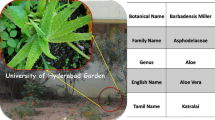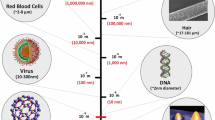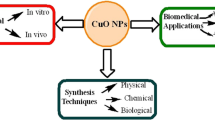Abstract
In this study, the effects of intracellular delivery of various concentrations of gallic acid (GA) as a semistable antioxidant, gallic acid-loaded mesoporous silica nanoparticles (MSNs-GA), and cellular uptake of nanoparticles into Caco-2 cells were investigated. MSNs were synthesized and loaded with GA, then characterized using transmission electron microscopy (TEM), scanning electron microscopy (SEM), Fourier transform infrared spectroscopy, N2 adsorption isotherms, X-ray diffraction, and thermal gravimetric analysis. The cytotoxicity of MSNs and MSNs-GA at low and high concentrations were studied by means of 3-[4,5-dimethylthiazol-2-yl]-2,5-diphenyltetrazolium bromide (MTT) test and flow cytometry. MSNs did not show significant toxicity in various concentrations (0–500 μg/ml) on Caco-2 cells. For MSNs-GA, cell viability was reduced as a function of incubation time and different concentrations of nanoparticles. The in vitro GA release from MSNs-GA exhibited the same antitumor properties as free GA on Caco-2 cells. Flow cytometry results confirmed those obtained using MTT assay. TEM and fluorescent microscopy confirmed the internalization of MSNs by Caco-2 cells through nonspecific cellular uptake. MSNs can easily internalize into Caco-2 cells without deleterious effects on cell viability. The cell viability of Caco-2 cells was affected during MSNs-GA uptake. MSNs could be designed as suitable nanocarriers for antioxidants delivery.










Similar content being viewed by others
Abbreviations
- MSNs:
-
Mesoporous silica nanoparticles
- GA:
-
Gallic acid
- BJH:
-
Barrett–Joyner–Halenda
- BET:
-
Brunauer–Emmett–Teller
- SEM:
-
Scanning electron microscopy
- TEM:
-
Transmission electron microscopy
- FT-IR:
-
Fourier transform infrared spectroscopy
- MTT:
-
3-[4,5-Dimethylthiazol-2-yl]-2,5-diphenyltetrazolium bromide
- ROS:
-
Reactive oxygen species
- Caco-2:
-
Human colon carcinoma
- MSNs-GA:
-
Mesoporous silica nanoparticles loaded by GA
References
Aiyegoro OA, Okohy AI (2010) Preliminary phytochemical screening and In vitro antioxidant activities of the aqueous extract of Helichrysum longifolium DC. BMC Complement Altern Med (CAM) 1:10–21
Carriazo D, Arco MD, Martín C, Ramos C, Rives V (2010) Influence of the inorganic matrix nature on the sustained release of naproxen. Micropor Mesopor Mater 130:229–238
Cauda V, Engelke H, Sauer A, Arcizet D, Brauchle C, Radler J, Bein T (2010) Colchicine-loaded lipid bilayer-coated 50 nm mesoporous nanoparticles efficiently induce microtubule depolymerization upon cell uptake. Nano Lett 10:2484–2492
Chang SS, Kibel AS (2008) The role of systemic cytotoxic therapy for prostate cancer. BJU Int 103:8–17
Chung TH, Wu SH, Yao M, Lu CW, Lin YS, Hung Y, Mou CY, Chen YC, Huang DM (2007) The effect of surface charge on the uptake and biological function of mesoporous silica nanoparticles 3T3-L1 cells and human mesenchymal stem cells. Biomaterials 28:2959–2966
Chuysinuan P, Chimnoi N, Techasakul S, Supaphol P (2009) Gallic acid-loaded electrospun poly(l-lactic acid) fiber mats and their release characteristic. Macromol Chem Phys 210:814–822
Elvira GM, Chandra S, Marco Vinicio RM, Wenyi W (2006) Catalytic inhibition of human DNA topoisomerase by phenolic compounds in Ardisia compressa extracts and their effect on human colon cancer cells. Food Chem Toxicol 44:1191–1203
Gao L, Sun J, Li Y (2011) Functionalized bimodal mesoporous silicas as carriers for controlled aspirin delivery. J Solid State Chem 184:1909–1914
Gary-Bobo M, Hocine O, Brevet D, Maynadier M, Raehm L, Richeter S, Charasson V, Loock B, Morère A, Maillard P, Garcia M, Durand JO (2012) Cancer therapy improvement with mesoporous silica nanoparticles combining targeting, drug delivery and PDT. Int J Pharm 423:509–515
He Q, Shi J (2012) Mesoporous silica nanoparticle based nano drug delivery systems: synthesis, controlled drug release and delivery, pharmacokinetics and biocompatibility. J Mater Chem 21:5845–5855
Hu H, Nie L, Feng S, Suo J (2013a) Preparation, characterization and in vitro release study of gallic acid loaded silica nanoparticles for controlled release. Pharmazie 68(6):401–405
Hu X, Hao X, Wu Y, Zhang J, Zhang X, Wang PC, Zou G, Liang XJ (2013b) Multifunctional hybrid silica nanoparticles for controlled doxorubicin loading and release with thermal and pH dual response. J Mater Chem B 1:1109–1118
Huang DM, Hung Y, Ko BS, Hsu SC, Chen WH, Chien CL, Tsai CP, Kuo CT, Kang JC, Yang CS, Mou CY, Chen YC (2005) Highly efficient cellular labeling of mesoporous nanoparticles in human mesenchymal stem cells: implication for stem cell tracking. FASEB J 19:2014–2016
Huang DM, Chung TH, Hung Y, Lu F, Wu SH, Mou CY, Yao M, Chen YC (2008) Internalization of mesoporous silica nanoparticles induces transient but not sufficient osteogenic signals in human mesenchymal stem cells. Toxicol Appl Pharm 231:208–215
Huang X, Teng X, Chen D, Tang F, He J (2010) The effect of the shape of mesoporous silica nanoparticles on cellular uptake and cell function. Biomaterials 31:438–448
Huang PG, Hseu YC, Lee MS, Senthil Kumar KJ, Wu CR, Hsu LS, Liao JW, Cheng IS, Kuo YT, Huang SY, Yang HL (2012) In vitro and in vivo activity of gallic acid and Toona sinensis leaf extracts against HL-60 human premyelocytic leukemia. Food Chem Toxic 50:3489–3497
Inoue M, Sakaguchi N, Isuzugawa K, Tani H, Ogihara Y (2000) Role of reactive oxygen species in gallic acid-induced apoptosis. Biol Pharm Bull 23:1153–1157
Jia L, Shen J, Li Z, Zhang D, Zhang Q, Duan C, Liu G, Zheng D, Liu Y, Tian X (2012) Successfully tailoring the pore size of mesoporous silica nanoparticles: exploitation of delivery systems for poorly water-soluble drugs. Int J Pharm 439:81–91
Kaur M, Velmurugan B, Rajamanickam S, Agarwal R, Agarwal C (2009) Gallic acid, an active constituent of grape seed extract, exhibits anti-proliferative, proapoptotic and anti-tumorigenic effects against prostate carcinoma xenograft growth in nude mice. Pharm Res 26:2133–2140
Kawada M, Ohno Y, Ri Y, Ikoma T, Yuugetu H, Asai T, Watanabe M, Yasuda M, Akao S, Takemura G, Minatoguchi S, Gotoh K, Fujiwara H, Fukuda K (2001) Anti-tumor effect of gallic acid on LL-2 lung cancer cells transplanted in mice. Anti Cancer Drug 12:847–852
Kim SH, Jun CD, Suk K, Choi BJ, Lim H, Park S, Lee SH, Shin HY, Kim DK, Shin TY (2006) Gallic acid inhibits histamine release and pro-inflammatory cytokine production in mast cells. Toxicol Sci 91:123–131
Kratz JM, Andrighetti-Frohner CR, Leal PC, Nunes RJ, Yunes RA, Trybala E, Bergstrom T, Barardi CR, Simoes CM (2008) Evaluation of anti-HSV-2 activity of gallic acid and pentyl gallate. Biol Pharm Bull 31:903–907
Lin QN, Huang Q, Li CY, Bao CY, Liu ZZ, Li FY, Zhu LY (2010) Anticancer drug release from a mesoporous silica based nanophotocage regulated by either a one- or two-photon process. J Am Chem Soc 132:10645–10647
Lu J, Liong M, Zink JI, Tamanoi F (2007) Mesoporous silica nanoparticles as a delivery system for hydrophobic anticancer drugs. Small 3:1341–1346
Meng H, Liong M, Xia T, Li Z, Ji Z, Zink JI, Nei AE (2010) Engineering design of mesoporous silica nanoparticles to deliver doxorubicin and p-glycoprotein sirna to overcome drug resistance in cancer cell line. ACS Nano 4:4539–4550
Mortera R, Vivero-Escoto J, Slowing II, Garrone E, Onida B, Lin VSY (2009) Cell-induced intracellular controlled release of membrane impermeable cysteine from a mesoporous silica nanoparticle-based drug delivery system. Chem Commun 22:3219–3221
Munin A, Edwards-Lévy F (2011) Encapsulation of natural polyphenolic compounds; a review. Pharmaceutics 3:793–829
Nici E (2010) Assessment of antioxidant capacity in vitro and in vivo. Free Radic Biol Med 49:503–515
Pal C, Bindu S, Dey S, Alam A, Goyal M, Iqbal MS, Maity P, Adhikari SS, Bandyopadhyay U (2010) Gallic acid prevents nonsteroidal anti-inflammatory drug-induced gastropathy in rat by blocking oxidative stress and apoptosis. Free Radic Biol Med 49:258–267
Radu DR, Lai CY, Jeftinija K, Row EW, Jeftinija S, Lin VSY (2004) A polyamidoamine dendrimer-capped mesoporous silica nanosphere-based gene transfection reagent. J Am Chem Soc 126:13216–13217
Rashidi L, Khosravi-Darani K (2011) The applications of nanotechnology in food industry. Crit Rev Food Sci 51:723–730
Rosenholm JM, Peuhu E, Bate-Eya LT, Eriksson JE, Sahlgren C, Linden M (2010) Cancer-cell-specific induction of apoptosis using mesoporous silica nanoparticles as drug-delivery vectors. Small 6:1234–1241
Russell LH Jr, Mazzio E, Badisa RB, Zhu Z-P, Agharahimi M, Oriaku ET, Goodman CB (2012) Autoxidation of gallic acid induces ROS-dependent death in human prostate cancer LNCaP cells. Anticancer Res 32:1595–1602
Sahay G, Alakhova DY, Kabanov AV (2000) Endocytosis of nanomedicines. J Control Release 145:182–195
Slawinska D, Polewski K, Rolewski P, Slawinski J (2007) Synthesis and properties of model humic substances derived from gallic acid. Int Agrophysics 21:199–208
Slowing II, Trewyn BG, Lin VSY (2007) Mesoporous silica nanoparticles for intracellular delivery of membrane impermeable proteins. J Am Chem Soc 129:8845–8849
Torney F, Trewyn BG, Lin VSY, Wang K (2007) Mesoporous silica nanoparticles deliver DNA and chemicals into plants. Nat Nanotechnol 2:295–300
Vivero-Escoto JL, Slowing II, Trewyn BG, Lin VSY (2010a) Mesoporous silica nanoparticles for intracellular controlled drug delivery. Small 6:1952–1967
Vivero-Escoto JL, Slowing II, Lin VSY (2010b) Tuning the cellular uptake and cytotoxicity properties of oligonucleotide intercalator functionalized mesoporous silica nanoparticles with human cervical cancer cells Hela. Biomaterials 31:1325–1333.
Wani A, Muthuswamy E, Layan-Savithra GH, Mao G, Brock S, Oupický D (2012) Surface functionalization of mesoporous silica nanoparticles controls loading and release behavior of mitoxantrone. Pharm Res 29:2407–2418
You BR, Park WH (2010) Gallic acid-induced lung cancer cell death is related to glutathione depletion as well as reactive oxygen species increase. Toxicol In Vitro 24:1356–1362
You BR, Moon HJ, Han YH, Park WH (2010) Gallic acid inhibits the growth of HeLa cervical cancer cells via apoptosis and/or necrosis. Food Chem Toxicol 48:1334–1340
Zhang Y, Zhi Z, Jiang T, Zhang J, Wang Z, Wang S (2010) Spherical mesoporous silica nanoparticles for loading and release of the poorly water-soluble drug telmisartan. J Control Release 145:257–263
Zhao Y, Trewyn BG, Slowing II, Lin VSY (2009) Mesoporous silica nanoparticle-based double drug delivery system for glucose-responsive controlled release of insulin and cyclic AMP. J Am Chem Soc 131:8398–8400
Zheng J, Tian X, Sun Y, Yang W (2013) pH-sensitive poly(glutamic acid) grafted mesoporous silica nanoparticles for drug delivery. Int J Pharm 450:296–303
Acknowledgments
The authors acknowledge the Stem Cell Technology Research Center which provided some instrumental facilities.
Author information
Authors and Affiliations
Corresponding author
Rights and permissions
About this article
Cite this article
Rashidi, L., Vasheghani-Farahani, E., Soleimani, M. et al. A cellular uptake and cytotoxicity properties study of gallic acid-loaded mesoporous silica nanoparticles on Caco-2 cells. J Nanopart Res 16, 2285 (2014). https://doi.org/10.1007/s11051-014-2285-6
Received:
Accepted:
Published:
DOI: https://doi.org/10.1007/s11051-014-2285-6




